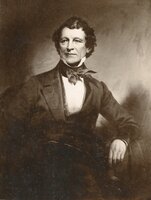-

First page of African Repository reprint of Benjamin Silliman's speech, "Some of the Causes of National Anxiety." Silliman expressed that “Visionary attempts to elevate, suddenly, the free colored population,” with a college education were “impracticable” or possibly “injurious.” Instead, Silliman stressed the need for “religious, moral and instructed men… acquaint[ed] with business and with useful arts and trades” to support colonization.
-

First page of Benjamin Silliman's 1837 article “Remarks on Some of the Gold Mines, and on Parts of the Gold Region of Virginia..." Silliman failed to mention that most of the mines he observed were worked by enslaved people though he mentioned it in his private journal.
-

Political cartoon depicting northern states being used by the South to recapture enslaved people who had runaway. Antislavery northerners used cartoons like this one to criticize the Fugitive Slave Act of 1850. In the cartoon, a white man points at Black men across the Canadian border, yelling "Seize him! Seize him!." Dogs wearing collars inscribed with "Ohio" and "Indiana" pursue the Black figures on command. Engraved by William H. Burridge from an illustration by Mary Hallock Foote.
-

Photograph of the vellum manuscript for the Constitution of Vermont.
-

Photograph portrait of Dr. Ashbel Smith
-

Photograph of Dr Ashbel Smith statue, Baytown, Texas. The statue's plinth includes the inscription "Life has duties to perform to its last moment. This world is not a resting place."
-

1890 Ashbel Smith Building on the campus of the University of Texas Medical Branch on Galveston Island, Texas.
-

Excerpt from November 24, 1839 Durant H. Davis letter to Ashbel Smith describing the enslaved people had recently purchased in Tennessee.
-

Excerpt from November 24, 1839 Durant H. Davis letter to Ashbel Smith asking Smith to speak to another enslaver named “Johnson” regarding his potential purchase of an enslaved woman for sexual slavery. Davis states that he has several enslaved women he believes would be suitable for this purpose.
-

Excerpt from November 24, 1839 Durant H. Davis letter to Ashbel Smith discussing an enslaved woman named "Mary."
-

Photograph of Reverend Noah Benedict House (1760) at 256 Main Street South in Woodbury, CT
-

Noah Benedict's business card listing his education: "Med. Inst. of Yale; Classes of 1831-2 + 1832-3."
-

Map of Chambers County, Texas, showing the likely location of Smith’s plantation just across the Harris County line in what is now Baytown, Texas
-

Painting of a large cotton plantation in antebellum Louisiana (Bois de Flèche Plantation in St. Landry Parish) similar to Sprowl Plantation, showing the slave quarters, cotton press, and main house in the background
-

Lithograph of tobacco fields, enslaved quarters, and horse-mounted overseers similar to those that would have existed on “La Carolina.” First published as Frédéric Mialhe, “Vista de una vega de tabaco,” “Plate XXVII” in Album Pintoresco de la Isla de Cuba (Havana: B. May y Ca., 1851).
-

Digital recreation of the Crossland Banner, which was the state flag of Maryland secessionists who joined the Confederacy during the Civil War.
-

Dr. George B. Wood, former physician and professor at the University of Pennsylvania.
-

Emblem of the Calliopean Society, Yale's proslavery debate society (c. 1819). Downloaded from Wikimedia
-

Receipt of payment to John W. Creed from Calliopean Society for “fifteen dollars in full for services” (dated October 14, 1846).
-

Receipt of payment from Calliopean Society for “$15.00 in full for services” accepted by Courtlandt Creed on February 8, 1850.
-

Photograph of historical marker for Ashbel Smith in Baytown, Texas, noting Yale medical degree.
-

Illustration of Amistad insurrection from John W. Barber, A History of the Amistad Captives: Being a Circumstantial Account of the Capture of the Spanish Schooner Amistad, by the Africans on Board… (New Haven, CT: E.L. & J.W. Barber. Hitchcock & Stafford, 1840).
-

Charles Hooker was the first dean of the Medical Institution of Yale College. This portrait hangs in Sterling Hall of Medicine.
-

Oil portrait on canvas of Thomas Hubbard by unknown artist.
-

Page from Jonathan Knight's daybook showing an entry for a “negro” patient whom Knight saw “at Wm. Pinto” on May 21, 1819, charging either the patient or Pinto for “di[agnosis]” and “advice” [NB: entry is in the middle of the page].

























